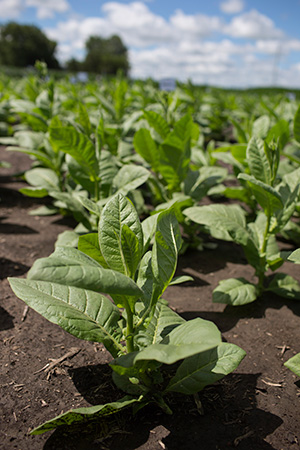DOI: 10.1093/jxb/eru156
Transplastomic integration of a cyanobacterial bicarbonate transporter into tobacco chloroplasts
Abstract
 Improving global yields of agricultural crops is a complex challenge with evidence indicating benefits in productivity are achieved by enhancing photosynthetic carbon assimilation. Towards improving rates of CO2 capture within leaf chloroplasts, this study shows the versatility of plastome transformation for expressing the Synechococcus PCC7002 BicA bicarbonate transporter within tobacco plastids. Fractionation of chloroplast membranes from transplastomic tobBicA lines showed that ~75% of the BicA localized to the thylakoid membranes and ~25% to the chloroplast envelope. BicA levels were highest in young emerging tobBicA leaves (0.12 μmol m–2, ≈7 mg m–2) accounting for ~0.1% (w/w) of the leaf protein. In these leaves, the molar amount of BicA was 16-fold lower than the abundant thylakoid photosystem II D1 protein (~1.9 μmol m–2) which was comparable to the 9:1 molar ratio of D1:BicA measured in airgrown Synechococcus PCC7002 cells. The BicA produced had no discernible effect on chloroplast ultrastructure, photosynthetic CO2-assimilation rates, carbon isotope discrimination, or growth of the tobBicA plants, implying that the bicarbonate transporter had little or no activity. These findings demonstrate the utility of plastome transformation for targeting bicarbonate transporter proteins into the chloroplast membranes without impeding growth or plastid ultrastructure. This study establishes the span of experimental measurements required to verify heterologous bicarbonate transporter function and location in chloroplasts and underscores the need for more detailed understanding of BicA structure and function to identify solutions for enabling its activation and operation in leaf chloroplasts.
Improving global yields of agricultural crops is a complex challenge with evidence indicating benefits in productivity are achieved by enhancing photosynthetic carbon assimilation. Towards improving rates of CO2 capture within leaf chloroplasts, this study shows the versatility of plastome transformation for expressing the Synechococcus PCC7002 BicA bicarbonate transporter within tobacco plastids. Fractionation of chloroplast membranes from transplastomic tobBicA lines showed that ~75% of the BicA localized to the thylakoid membranes and ~25% to the chloroplast envelope. BicA levels were highest in young emerging tobBicA leaves (0.12 μmol m–2, ≈7 mg m–2) accounting for ~0.1% (w/w) of the leaf protein. In these leaves, the molar amount of BicA was 16-fold lower than the abundant thylakoid photosystem II D1 protein (~1.9 μmol m–2) which was comparable to the 9:1 molar ratio of D1:BicA measured in airgrown Synechococcus PCC7002 cells. The BicA produced had no discernible effect on chloroplast ultrastructure, photosynthetic CO2-assimilation rates, carbon isotope discrimination, or growth of the tobBicA plants, implying that the bicarbonate transporter had little or no activity. These findings demonstrate the utility of plastome transformation for targeting bicarbonate transporter proteins into the chloroplast membranes without impeding growth or plastid ultrastructure. This study establishes the span of experimental measurements required to verify heterologous bicarbonate transporter function and location in chloroplasts and underscores the need for more detailed understanding of BicA structure and function to identify solutions for enabling its activation and operation in leaf chloroplasts.
